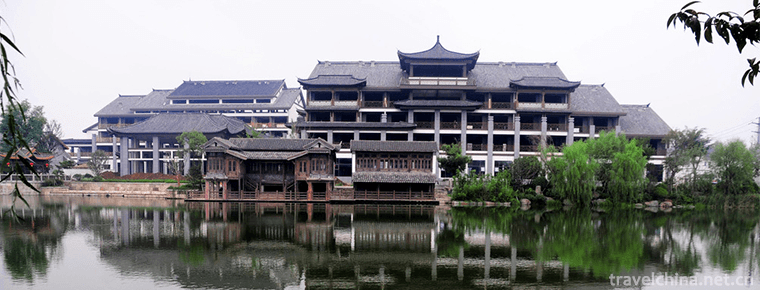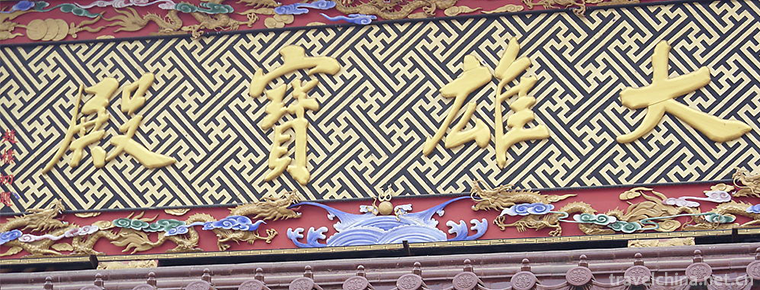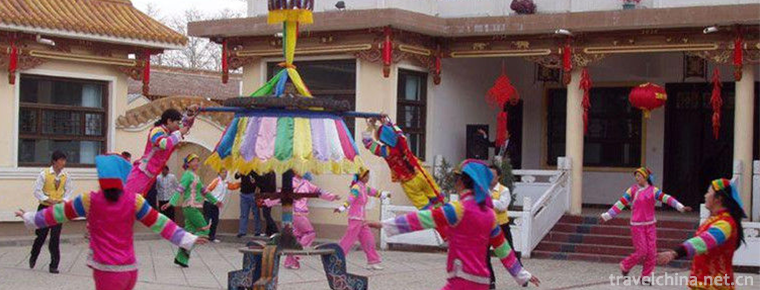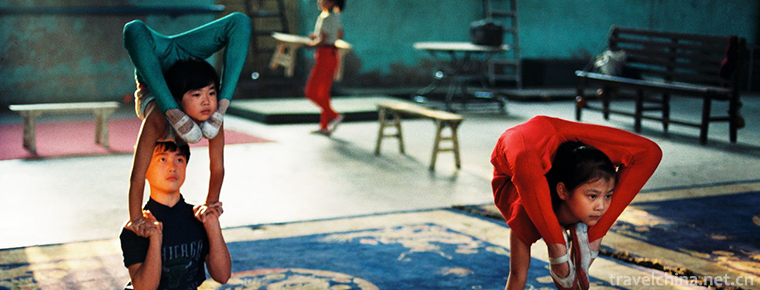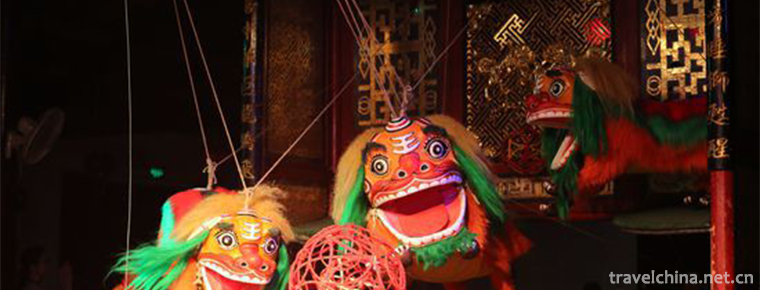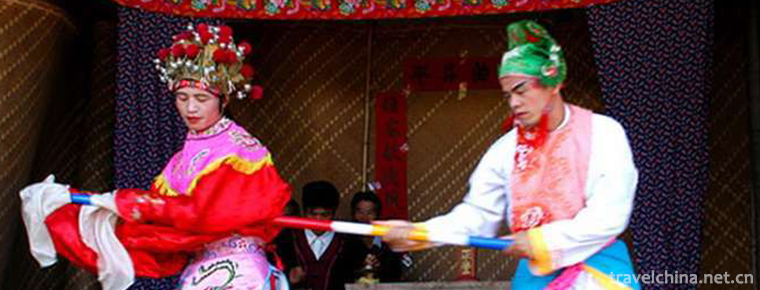Guan Lin Scenic Area
Guanlin, a national key cultural relic protection unit, National AAAA tourist attraction, is the first place for the burial of Shu generals Guanyu in the Three Kingdoms period. The former is an ancestral temple, and the latter is a tomb. It is located in Guanlin Town, Luolong District, Luoyang City, Henan Province.
Guanlin is one of the three major temples at home and abroad. It is the only ancient classical building in China that combines tombs, temples and sacrifices.
Guanlin was built in the Ming and Wanli Dynasties, and expanded in the Qing and Qianlong Dynasties. The existing buildings are mainly Ming Dynasty, which is a well-preserved ancient building complex. Guanlin's architectural specifications are built in the form of palaces with a rigorous and spectacular layout. There is a stage in front of the temple. The central axis buildings are gates, Yimen, Yongdao, worship hall, hall, second hall, three halls, stone archway, forest stele Pavilion and tomb closure. Symmetrical buildings of the same form are attached to both sides of the central axis. Among them, the most distinctive dance building is the Xieshan style of the front stage and the hard mountain style of the back stage. The double eaves Pavilion is rare in the whole country, and it is also the location of "Luoyang Ancient Art Museum".
Guan Gong Faith and Customs declared by Luoyang City in 2008 has been designated as the national intangible cultural heritage (No. 992X-85) by the State Council. As the heritage site of Guan Gong Faith and Customs in the national intangible cultural heritage list, Guanlin has become a cultural treasure shared by all mankind.
In 2016, Guanlin Scenic Area became a pilot unit of wisdom tourism in Luoyang City.
Historical evolution
In the winter of 219 AD, Sun Quan attacked Jingzhou, and Guan Yu retreated from Maicheng. In the first month of the spring of 220, Sun Quan was afraid of Liu Bei's revenge and put Guan Yu at the head of Cao Cao's office in Luoyang . But Cao Cao recognized Guan Yu as a man. Cao Cao worshipped Guan Yu as king of Jing and carved aloes as his body. He was buried 15 miles south of Luoyang City and built a temple to offer sacrifices. Now Guan Lin has been 1790 years.
In the Ming Dynasty, on the original site of Guan Temple in the Han Dynasty in the 20th year of Wanli (1592), Guan Lin Temple was expanded to cover more than 200 acres, four courtyards, more than 150 halls and corridors, and a large-scale public worship area of Guan. In the year of Wanli 33rd (1605), Guanyu was sealed up as "the Three Kingdoms Voldemort Emperor, Shenweiyuan Town, the Saint Emperor of Guanyu", and Guanyu was first sealed as "Saint".
In the Qing Dynasty, Guanyu was sealed up as the "Holy Emperor of Zhongyi Shenwuguan" in the fifth year of Shunzhi and Luoyang Guandi Mausoleum in the fifth year of Kangxi as the "Holy Emperor Lin of Zhongyi Shenwuguan", which was originally called "Guanlin", and became two holy areas standing side by side with the "Confucius Forest" in Qufu, Shandong Province. Yongzheng Eight Years (1730) Imperial Reform of the Wushu Temple. It was built during the reign of Qianlong in the Qing Dynasty and now covers an area of 180 mu. Guanlin was a place where emperors sent officials to worship, local officials and people worshipped Guan Gong during the Ming and Qing Dynasties.
In 1980, Luoyang Ancient Art Museum was set up in Guanlin to display ancient tablets and stone carvings.
In March 2001, Guanlin was awarded National AAAA Tourist Scenic Spot.
On May 25, 2006, as an ancient building from Ming to Qing Dynasty, Guanlin was approved by the State Council to be listed in the Sixth Batch of national key cultural relics protection units.
In 2008, Guanlin was designated by the State Council as the national intangible cultural heritage site (No. 992X-85), "Guan Gong Faith and Customs".
Main building
The main building of Guanlin was built in the 20th year of Wanli in Ming Dynasty (1592). Its layout was built in the shape of Hui according to the Imperial Palace building. Dance hall, gate, Yimen, Ping'an Hall, Caishen Hall, Spring and Autumn Hall, Guanlin (mound) are its north-south axis. The layout of other buildings are symmetrical along this line, which reflects the traditional characteristics of Chinese ancient architecture culture.
gate
The gate was built in the fifty-sixth year of Qianlong in the Qing Dynasty (1791). There were 981 golden nails on the middle gate, which was the symbol of the highest grade of the feudal social hierarchy. There are eight-character walls on both sides of the gate. They are inscribed with four big characters "loyalty" and "benevolence and bravery", which summarize Guan Yu's life of loyalty, loyalty, kindness and bravery.
secondary gate to an official residence
Yimen was built in the Ming Dynasty during Wanli Dynasty. It was the place where civilian officers came to get off the sedan chair and military officers to get off the horse. Originally the gate of Guandi Temple in Ming Dynasty, it was renamed Yimen in Qing Dynasty. On the forehead of the door, the plaque "Weiyang Liuhe" is the imperial pen of Empress Dowager Cixi, which is very precious. On the multicolored partition wall between the East and west of Yimen, each side is inlaid with carvings. On the East side, Yue Fei painted the image of Emperor Guan Shengdi, which was created by Yue Fei, a famous anti-gold general in Song Dynasty, in memory of Guan Yu's heroism and loyalty. On the West side, Guan Yu painted the poems of Emperor Guan. All the bamboo leaves in this bamboo painting are embellished into a poem: "Don't thank you for your kindness, Danqing's independent name, don't dislike lonely leaves, never fade".
Shishi royal road
From Yimen to the hall, Yongdao is 35 meters long and 4 meters wide, with 36 pillars and 104 stone lions on both sides. This stone lion Yongdao is known as "Luoyang Xiaolugou". According to the inscription, the existing Yongdao was rebuilt in the forty-seventh year of Wanli (1619) in the Ming Dynasty. It was donated by the merchants in Luoke and built according to the palace style.
The Shishi Royal Road is a special way for emperors or court officials to offer sacrifices. It is full of lions and lifelike. Because most of the pillars and fences of the imperial road are donated and built by the followers, they wish the business to flourish and the financial resources to expand. As soon as they go up, they often carve bronze money decorations, implying that all sides come to wealth, so they are also called "the way to make money" by the people.
Audience hall
Founded in the twenty-fourth year of Wanli in Ming Dynasty (1596), it covers seven rooms wide, three rooms deep and 26 meters high. The top of the Ludian Hall is covered with glazed tiles, with five ridges and six beasts. On the main door, there are 12 relief woodcarvings of Ming Dynasty. It tells stories such as the Three Rights in Taoyuan and the Three England War against Lv Bu.
Hall of worship: Located in front of the main hall and connected with it, it is a place of worship for hundreds of bureaucrats during the Spring and Autumn Festival. In the hall hangs the plaque of "Sound and Soul in Hyun" in the imperial script of Qianlong, and the plaque "The next Han Dynasty has both high and high divine achievements, and Fugang extends vast air and Yishui flows together".
Ping An Dian: Also known as the Kai Sheng Dian, is the main building of Guanlin, located in the center of the entire temple, carved beams, painted buildings, magnificent momentum. Inside the temple, there are statues of emperors pasted with gold. Guanping, Zhou Cang, Wang Fu and Liao Hua stand on both sides.
Two hall
Two halls and five rooms, Ludian style, hanging on the door of the "Guangzhao Sun and Moon" plaque, is the Qing Emperor Guangxu imperial theme. Guan Yu, a sculpture in the hall, glared at the Dongwu statue. On the left, Guan Ping, who was holding the big stick, and on the right, Zhou Cang, who was holding the big knife. There is a hard hill-like accompanying hall built around the two halls, with Zhang Hou Dian on the left and Wuhu Dian on the right. The three halls are hard hill style, with a wide surface and five rooms. They are small in scale. They are also called bedrooms for Guanyu to read the images of spring and autumn at night, Guanyu's travel plans and sleeping portraits.
The second hall, also known as the Temple of Wealth God, was built in the 20th year of Wanli in Ming Dynasty (1592). It was one of the earliest halls built in Guanlin Architecture. The "Guangzhao Sun and Moon" plaque written by Emperor Guangxu was hanging on the door of the hall. The statues of Guan Gong and Wu Gong were shaped inside. After Guanping and Zhou Cang separated with their swords, they recruited wealthy children and Lishi children to serve them. Throughout the ages, people have prayed here for prosperity of business, prosperity of financial fortune and prosperity of business.
Five Tigers Hall: the west side of the Temple of Wealth God, the Hall of Five Tigers is dedicated to Guan Yu, Zhang Fei, Zhao Yun, Ma Chao and Huang Zhong, so it is called. Renovation in the 20th year of Wanli Ming Dynasty (1592).
Niang Niang Dian: The east side of the Temple of Wealth God, built in the Ming Dynasty, is dedicated to Mrs. Hu of Guanyu, her daughter Tiger Daughter and her son Guanxing. In the hall, the East and west sides are painted with "expelling illness and praying for blessings" and "begging for children and returning wishes". Folk tradition says that Mrs. Hu can dispel illness and send her children away, so people often burn incense in front of the Niangniang Temple to dispel disaster and sincerely ask for heirs.
Three Hall
The three halls, also known as the Spring and Autumn Hall, also known as the bedroom hall, were built in the 22nd year of Jiaqing in the Qing Dynasty (1817). In front of the hall, there are two Qibai trees of Xuansheng and Yiyi. In the hall, the statue of reading "Spring and Autumn" and the sleeping statue of Guan Gong on public night are sculptured.
The monument of "loyal God Wuling Youren Yongwei Guan Saint Emperor Lin" stands in the pavilion before Guanlin (grave). The inscription records Guanyu's life story, title and temple building. It is an important basis for Guanlin to call it "Lin". It reflects emperors'noble worship of Guanyu and the continuous history of Guanlin's sacrifice. It also proves Guanlin's leadership in thousands of Guanyu temples at home and abroad. Sleeve temple status.
Guan Zhong
Guanyu Lingshou's burial site is 17 meters high and covers an area of 2600 square meters. The south wall of the tomb front has the stone tomb gate built by Kangxi in 56 years. The front of the tomb is titled "Zhong Lingshi", and the couplet of the tomb gates is "Shenyou Shangyuan Riding Crane, Bones Sleeping Dragon in the Heaven".
Beginning at the end of the Han Dynasty, nowadays the grass is covered and dusty. Although the rivers and mountains have been changed, the Yuan Tombs are still there. "Guanlin Cuibai" is one of the "eight small sceneries" in Luoyang. The ancient cypress has thousands of chapters and turns of green onions. Whenever the heavy rain is in a hurry, the clouds are like smoke, like incense seals, flowing around the graves, and the fantastic scenery is amazing. For thousands of years, Guan Yu, as the embodiment of loyalty and moral example, has been widely respected by the people. His "loyalty, righteousness, benevolence and courage" embodies the spirit of our Chinese nation. The special cultural phenomenon of "Guan Gong Belief" formed from this has become a bridge and link to communicate with Chinese people at home and abroad and their family ties. Every September 29, the International Pilgrimage Ceremony of Guanlin is held here. At that time, overseas Guanlin temples and Clan Organizations gather in Guanlin to hold a solemn pilgrimage ceremony. Guanlin has become a sacred place for Chinese people at home and abroad to worship, and also a well-known tourist attraction at home and abroad.
Epitaph Room of Stele Inscription
There are more than 5000 inscriptions unearthed from Luoyang. The inscription covers the origin of the family, the division of the countryside, folk customs and important historical events. For example, the epitaphs of Father and Son of the Northern Wei and Yuan Dynasties on display reflect the changes of Xuanguang and the difficulties of Heyin; the epitaphs of Huguoding Dingyuan Marquis record the last period of his life, which is the festival of riding horses and galloping along the frontier; the epitaphs of Tang Dynasty not only reproduce the beauty of mature calligraphy, but also engrave many little-known historical facts; and the epitaphs of Qianlu record the political and military background of the submission of land and the surrender of the Northern Song Dynasty. Benefits beyond common sense. Epitaphs are collective carriers, unique cultural phenomena in China, and precious historical and cultural heritage.
Stone house
It is 10 meters wide, 6 meters high and has three doors. There are many inscriptions in Fangshang, which are all in praise of Guan Yu. The style of calligraphy is Ming and Qing Dynasty calligraphy.
Octagonal pavilion
Founded in the five years of Kangxi in the Qing Dynasty (1666), the structure is exquisite and unique. Inside the pavilion, there are stone tablets with tortoise's fall, 4.8 meters high, carved dragons on the head of the tablet, and four characters with the forehead titled "Lefeng inscription". The inscription on the front of the monument, "God of loyalty, God of Wuling, Youren, Yongwei, Xiangguan Saint Emperor Lin", is the highest title given to Guanyu by emperors of all dynasties.
In 1980, after renovation, the "Luoyang Ancient Art Museum" was established to display many stone carvings and stele inscriptions unearthed in Luoyang in the galleries on both sides.
square
The Qianqiujian Building, standing on the square, is the place where the old "lamp, shadow, Gong and drum talk rises and falls", and the Ming stone lion, standing on both sides of the gate, has a majestic and inviolable majesty. There are 81 golden door nails embedded in the gate with rich feudal meaning, reflecting Guan Lin's lofty status and Guan Yu's glory behind him; the iron lion standing around Yimen weighing more than 3000 kilograms is a relic of the Ming Dynasty's worshippers of Guan Gong, which is still solemn and prestigious despite more than 400 years of ups and downs; the plaque "Weiyang Liuhe" of Yimen is Empress Dowager Cixi's Royal pen, dignified and precious; The stone lion royal road of the gate and the temple is unique to the Guan temple at home and abroad. 104 stone lions are carved on the top of the Yongzhu pillar. All kinds of lions are round and vivid. There is no sense of rigidity of stone carving. It represents the highest achievement of the stone carving art of the Central Plains in the Qianlong period. Dance building (also known as Qianqiu Jianlou), gate, ritual gate, worship hall, hall, second hall, three halls, Fengwen Stele Pavilion, Guanzhong, constitute the grand architectural pattern of Guanlin. There are many dragon heads in its main building, the most in Central Plains. The Fengwen Stele Pavilion built in the Kangxi Dynasty has a dignified structure. The octagonal pavilion is decorated with flourishing colors and exquisite wood carvings, all of which are wooden tenon structures, reflecting the amazing creativity of ancient architects.
position information
Guanlin is located in Guanlin Town, 7 kilometers south of the old city of Luoyang City, Henan Province. Guanlin is located in the hinterland of Kyushu, 112 degrees 16'-112 degrees 37', 34 degrees 32'-34 degrees 45', at the junction of the second and third steps in China. The eastern section of the Eurasian Continental Bridge is about 179 kilometers long in East and 168 kilometers wide in North and south. Crossing the north and south sides of the middle reaches of the Yellow River, Zhengzhou in the east, Sanmenxia in the west, Jiaozuo in the north, Pingdingshan and Nanyang in the south.
Tourism information
Tickets and Transportation
Ticket: 40 yuan, student ticket 20 yuan.
Opening time: 8:00-17:00 a day.
Transportation: Take bus No. 55, 58, 69, 15, 39, 71, 81 to Guanlin Temple.
Browsing routes in scenic spots
Theatre building-gate-Yimen (Guandi's silk bamboo, Guandi's riding statue) - Lion Yong Road-Zhonggu Tower-Huabiao-incense burner-dragon, Fengbai-Zhang Xueliang's monument-platform-Baidian (drum, bell, seal) - hall-two halls (brick and tile) - Niang Dian, Wuhu Dian-Xuansheng Bai, Jieyi Bai-three halls-Ming, Qing stone archway-seal monument pavilion-Guanlin (gravel) - monument.












-
Shanghai
People's Republic of China municipality directly under the central government.
Views: 268 Time 2018-10-12 -
Taierzhuang Ancient Town
Taierzhuang Ancient City, located at the center of the Beijing-Hangzhou Grand Canal, is located at the junction of Taierzhuang District, Zaozhuang City, Shandong Province.
Views: 114 Time 2018-12-08 -
wunv mountain city
Wunu Mountain City is a national key cultural relic protection unit. It was built by Zhu Meng, the ancestor of Koguryo. The three gates of the city are narrow at the bottom of the wall.
Views: 142 Time 2018-12-22 -
Red Leaf Valley Eco cultural Tourist Area
Red Leaf Valley Eco-cultural Tourist Area, National Key Scenic Spot, National AAAA Class Tourist Spot. Red Leaf Valley is located in the southern mountain area of Jinxiuchuan Township.
Views: 193 Time 2019-01-16 -
Nanhai Chan Temple
Nanhai Chan Temple, a national AAAA scenic spot, is located in the southeast corner of Runan County, Zhumadian City, Henan Province, China.
Views: 121 Time 2019-02-07 -
Yasuaki
Anzhao is an ancient Tu dance. It's popular with mutual aid. When celebrating festivals, harvest celebrations and weddings, people gather in the courtyard or on the wheat threshing ground to dance the.
Views: 185 Time 2019-04-02 -
Liaocheng acrobatics
Liaocheng acrobatics is a traditional folk acrobatics art in Shandong Province. Liaocheng is one of the birthplaces of Chinese acrobatics. In the late Neolithic period, Liaocheng was the main area whe.
Views: 147 Time 2019-05-13 -
Ningde Huo Boy Line Lion
Ningde Huo children's lion is a traditional folk culture, which controls the lion's movement and expression through silk thread. Line lion is mainly pulled by head rope, tail rope and parotid rope, so.
Views: 73 Time 2019-06-08 -
Tin carving
Tin sculpture, the traditional Chinese sculpture art, is a unique craft in China and even in the world. It has a history of more than 300 years. The craft has a long history and has a long history. In.
Views: 331 Time 2019-07-01 -
Yongan Daqiang Opera
Yongan Daqiang Opera was formed in the mid-Ming Dynasty. It is a genre of Yiyang Opera. It is called Daqiang Opera because it is "big gong, big drum and big voice singing high tune". During .
Views: 215 Time 2019-07-14 -
The Story of the Hundred Birds Clothes of the Zhuang Nationality
At the beginning of liberation, Guangxi was a remote part of China at that time, but the appearance of Hundred Birds'Clothes showed that Guangxi was not a barren place for literature, and the minority.
Views: 202 Time 2019-08-16 -
Dazhou peoples life
In 2018, the per capita disposable income of Dazhou residents was 20881 yuan. The per capita disposable income of urban residents was 30882 yuan, an increase of 8.8%. Among them, salary income was 17597 yuan, an increase of 7.3%; net ope.
Views: 143 Time 2020-12-20

